Friday, March 29, 2013
Francesca D'Onofrio Stamford resident
Francesca Bambino D'Onofrio Stamford mediator and resident homes the techniques taught at CMI can be implements here. Peshawar, Pakistan (CNN) - The Pakistani Taliban claimed responsibility for a blast that killed 10 people near the U.S. Consulate in Peshawar on Friday.
A suicide bomber rode a motorbike up to a security checkpoint a third of a mile from the consulate and detonated 22 pounds of explosives attached to his body, police spokesman Mohammad Faisal said. Along with those killed, the strike also injured 31 others, Pakistani military officials said.
Violent attacks occur frequently around Peshawar, which is in Pakistan's northwest near the border with Afghanistan and adjacent to Pakistan's tribal region.
Among the dead were four men and two women. No one from the consulate was injured in the blast, military officials said.
Taliban spokesman Ehsanullah Ehsan passed along the claim of responsibility to CNN in a phone conversation.
A week ago, a car bomb exploded at a nearby camp for internally displaced people, killing 12 and injuring 32 others. The Jalozai camp houses hundreds of thousands of people who have left the country's tribal region.
Peshawar is the capital of Khyber Pakhtunkhwa, which is rife with Islamic extremists, including the Pakistani Taliban. It has been the site of recent clashes between Pakistani security forces and militants.
Thursday, March 21, 2013
Francesca Donofrio Stamford Mediator agrees with Obama
Francesca Donofrio Stamford Mediator agrees with President Obama, it is all about perspective. Francesca Bambino D'Onofrio the executive director at CMI, Stamford Connecticut's leading Mediation institutes lays the foundation in successful mediaton on perspective and truly partaking in it. Jerusalem (CNN) -- President Barack Obama tried Thursday to invigorate the stalled Middle East peace process, urging young Israelis to pressure their leaders to seek peace with Palestinians while acknowledging the Jewish state's historical right to exist and defend itself from continuing threats.
In a speech in Jerusalem that Obama had said would lay out his vision for the region, the president urged Israelis to look at the world through the eyes of Palestinians but also said enemies of Israel must change their rhetoric and tactics to reflect modern reality.
"You are not alone," Obama said in both English and Hebrew, prompting a standing ovation when he declared that "those who adhere to the ideology of rejecting Israel's right to exist might as well reject the Earth beneath them and the sky above, because Israel is not going anywhere."
Hours before the speech on the second day of a Middle East swing, two rockets fired from Palestinian-controlled Gaza landed in southern Israel.
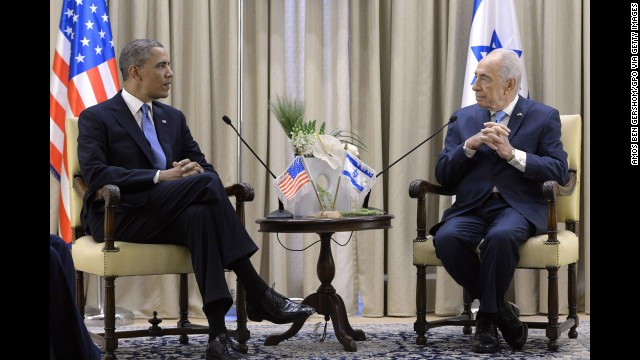 Photos: Obama visits Israel
Photos: Obama visits Israel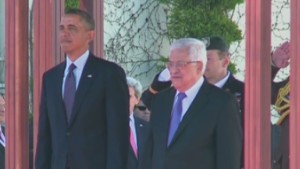 President Obama arrives in Ramallah
President Obama arrives in Ramallah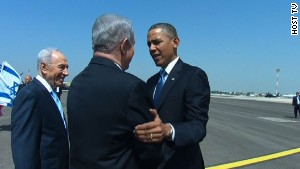 Obama in Israel for historic visit
Obama in Israel for historic visit
They caused no injuries or major damage, but served as a symbolic welcome to Obama's visit to the West Bank on Thursday to meet with Palestinian President Mahmoud Abbas. A hardline group claimed responsibility.
Israel honors Obama
In another symbolic moment, Obama received Israel's highest civilian honor -- the Presidential Medal of Distinction -- Thursday night from Israeli President Shimon Peres at a state dinner that emphasized the close ties between their countries.
Noting the similarity between the histories of Israelis and African-Americans as former slaves who endured hardship before gaining freedom in a new land, Obama said, "Our very existence, our presence here tonight, is a testament that all things are possible."
The earlier talks with Abbas served as a counterbalance to Obama's meetings the previous day with Israeli Prime Minister Benjamin Netanyahu, setting up the Jerusalem speech that addressed crucial issues of the stalled peace process as well as regional concerns such as the civil war in neighboring Syria and Iran's efforts to develop a nuclear weapon.
When Obama mentioned the name of Abbas in his speech Thursday, some boos erupted in the Jerusalem Convention Center among the audience of mostly young Israelis. He also was interrupted at one point by a protester's shouts, causing the president to joke that the heckling "made me feel at home" in reference to the caustic political climate in Washington.
Obama acknowledged the difficulty in resolving the Israeli-Palestinian impasse, but insisted that "peace is possible" and called on young Israelis to make it happen.
"Political leaders will not take risks if the people do not demand that they do," Obama said to applause, adding a familiar theme from his U.S. campaign speeches in declaring "you must create the change that you want to see."
Such a direct appeal to young Israelis was a "bold and courageous" move by Obama, according to Martin Indyk, a former U.S. ambassador to Israel who now is vice president and director of foreign policy at the Brookings Institution in Washington.
Noting that the president lowered expectations before his trip of what he could accomplish, Indyk told CNN that Obama now raised expectations "sky high" that he was going to personally work to make peace possible.
Kerry staying for more talks
Recently appointed Secretary of State John Kerry, who accompanied Obama on the trip that ends Friday in Jordan, will stay on to hold more talks with Israeli leaders, a senior administration official told reporters in a background briefing.
"We've done a lot of talking, a lot of listening over the course of the last two days, we'll do some more tomorrow, and then I think it'll be appropriate for Secretary Kerry to discuss next steps when he returns here," the official said.
Obama said in his speech that he believes "the Israeli people do want peace, and you have every right to be skeptical that it can be achieved," arguing that an end to the seemingly endless conflict is necessary and "the only path to true security" for Israel.
"Given the demographics west of the Jordan River, the only way for Israel to endure and thrive as a Jewish and democratic state is through the realization of an independent and viable Palestine," Obama said. "Given the frustration in the international community, Israel must reverse an undertow of isolation. And given the march of technology, the only way to truly protect the Israeli people is through the absence of war -- because no wall is high enough, and no Iron Dome is strong enough, to stop every enemy from inflicting harm. "
At the same time, he urged Israelis to empathize with the plight of Palestinians, using direct and harsh imagery to make his point.
"Put yourself in their shoes -- look at the world through their eyes," he said. "It is not fair that a Palestinian child cannot grow up in a state of her own, and lives with the presence of a foreign army that controls the movements of her parents every single day. It is not just when settler violence against Palestinians goes unpunished. It is not right to prevent Palestinians from farming their lands; to restrict a student's ability to move around the West Bank; or to displace Palestinian families from their home."
He added that "neither occupation nor expulsion is the answer," saying, "just as Israelis built a state in their homeland, Palestinians have a right to be a free people in their own land."
Arab states must seek normalized relations with Israel, and Palestinians must "recognize that Israel will be a Jewish state, and that Israelis have the right to insist upon their security," Obama also said.
Obama: Israeli settlements 'counterproductive'
He prompted applause from the young Israeli crowd when he criticized their government's controversial policy of building new settlements in disputed territories.
"Israelis must recognize that continued settlement activity is counterproductive to the cause of peace, and that an independent Palestine must be viable -- that real borders will have to be drawn," Obama said.
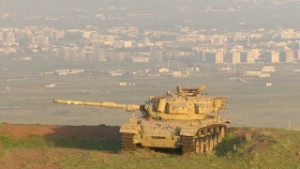 Israelis watching the war next door
Israelis watching the war next door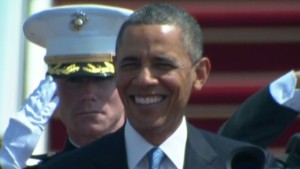 Obama's open mic slip in Israel
Obama's open mic slip in Israel
On a personal note, the president told how he met with young Palestinians before his speech and they differed little from his own daughters, adding that he believed Israeli parents would want Palestinian youths to succeed if they had a chance to talk to them.
During his earlier visit to to Ramallah in the West Bank, Obama stressed the need for direct talks between Israelis and Palestinians for a two-state solution.
"The Palestinian people deserve an end to occupation and the daily indignities that come with it," he said at a news conference with Abbas, adding that Palestinians deserve "a future of hope" and a "state of their own."
Obama said he and Abbas discussed, among other things, the Israeli settlements and the issue of Palestinian prisoners. He called for shunning the old habits, arguments and formulas that have stymied the peace process and envisioned "two nations, two neighbors at peace, Israel and Palestine."
At the news conference and in his later speech, Obama said the foundation for a peace agreement exists if both sides can overcome internal and external obstacles and pressure, and can join together making the leap.
The core issues right now, Obama said, are achieving sovereignty for Palestinians and security for Israel.
"That's not to say settlements are not important," he told reporters. "It is to say that if we solve those two problems, the settlement problem will be solved. So I don't want to put the cart before the horse. I want to make sure that we are getting to the core issues and the substance."
During a news conference on Wednesday with Netanyahu, neither leader mentioned the settlements, showing the sensitivity of the issue for the conservative prime minister who just formed a new coalition government after a narrow election victory.
In Ramallah on Thursday, Obama praised the Palestinian Authority led by Abbas but said Hamas, which governs Gaza, "has the responsibility to prevent" violations of a cease-fire with Israel such as the two rockets fired in the morning.
Abbas: Peace 'is necessary'
Abbas, however, said the Israeli settlements are "more than a hurdle to peace," calling them illegal and saying it was Israel's duty to stop building them.
At the same time, Abbas said Palestinians believe peace "is necessary and inevitable," and it should not be made through violence, occupation, walls, denial of refugee rights or settlements -- reciting a list of Palestinian grievances against Israel.
He envisioned a Palestinian state based on 1967 borders with Jerusalem as capital -- a scenario unacceptable to Israel.
On Wednesday, Obama and Netanyahu offered a "good cop-bad cop" approach to Iran's nuclear ambitions.
Both countries have accused Iran of secretly working toward building a nuclear weapon, and Netanyahu made it clear Wednesday after his talks with Obama that he believes the president is equally committed to preventing a nuclear-armed Iran.
In comments to reporters Wednesday and in Thursday's speech, Obama called for more diplomacy on Iran while endorsing Israel's right to defend itself as it sees fit. He also insisted that "all options" remain open -- code for a military strike to disable the Iranian program.
That prompted a warning Thursday from Iran's supreme leader, Ayatollah Khamenei, that Tehran would destroy Tel Aviv if Israel were to attack its nuclear facilities.
Obama also warned the Syrian government that using chemical weapons against opposition forces or allowing such weapons to be obtained by terrorists would be a "game-changer" in terms of U.S. involvement in the conflict. His administration has been criticized for not providing military aid to the Syrian opposition.
On Wednesday, Obama sought to assure Netanyahu and Israelis of his commitment to their security and to strengthen what have been strained personal and working relationships between the two men.
In what Netanyahu called a key development, the leaders announced new talks on extending U.S. military assistance to Israel for another 10 years past the current agreement, which expires in 2017.
Wednesday, March 20, 2013
Francesca Donofrio Stamford mediator on Pope Francis
Francesca Donofrio Stamford mediator shares this CNN article : Buenos Aires (CNN) -- Less than an hour after he fired off an angry letter to Catholic Church leaders about their handling of Argentina's same-sex marriage debate, Marcelo Marquez says his phone rang.
He was surprised to hear the voice on the other end of the line. It was Jorge Mario Bergoglio, then the archbishop of Buenos Aires, and now the pope.
What Bergoglio said to him at a meeting soon afterward that year, 2010, was even more surprising, Marquez said.
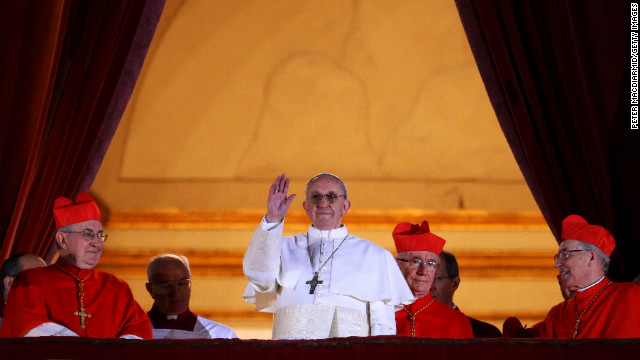 Photos: The new world pope
Photos: The new world pope The pope's wardrobe
The pope's wardrobe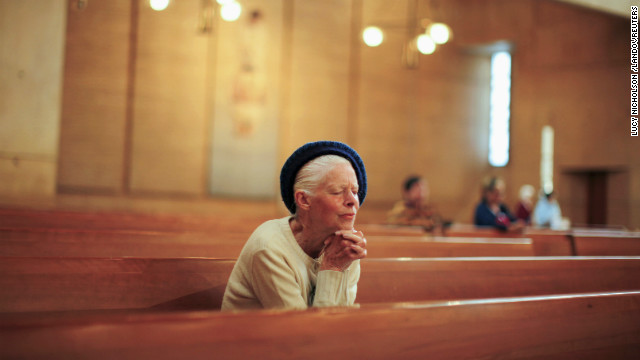 Photos: The world reacts to new pope
Photos: The world reacts to new pope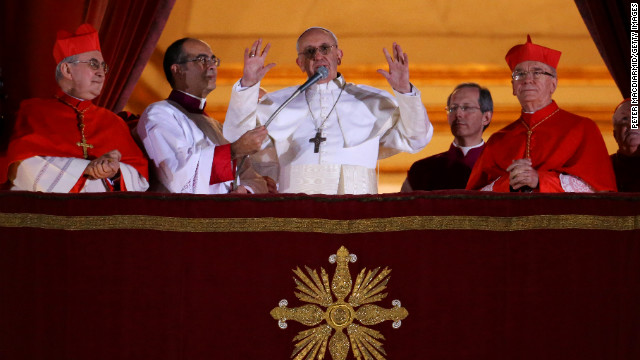 New pope: Scenes from St. Peter's Square
New pope: Scenes from St. Peter's Square
For months, church officials had made sharp, public criticisms of the push to legalize same-sex marriage in the South American country. But privately, Bergoglio seemed to be more open to discussion, according to Marquez.
"He told me. ... 'I'm in favor of gay rights and in any case, I also favor civil unions for homosexuals, but I believe that Argentina is not yet ready for a gay marriage law,'" said Marquez, a gay rights activist, a self-described devout Catholic and a former theology professor at a Catholic seminary.
As archbishop of Buenos Aires, Bergoglio was one of the leaders of the Catholic Church's public charge against legalizing same-sex marriage in Argentina. He engaged in a notorious war of words with the government of President Cristina Fernandez de Kirchner, who supported the measure.
Bergoglio put himself in the middle of the fight, calling the proposed legislation "a destructive attack on God's plan."
With a front-page counterpunch, the president said the church possessed "attitudes reminiscent of medieval times and the Inquisition."
Some point to the public battle as evidence of the traditionalist views of Bergoglio.
But behind closed doors, Marquez said, the man who would become pope appeared to be more open to discussion of the issue.
In another meeting, Bergoglio told him he had always treated gay people with respect and dignity.
"I have accompanied many homosexual people during my career to tend to their spiritual needs," Bergoglio said at the time, according to Marquez.
Bergoglio, who chose the name Pope Francis after he was elected pontiff last week, may have voiced his support for civil unions in other circles.
Andres Albertsen, a former pastor of the Danish Church in Buenos Aires, said Bergoglio made similar comments about civil unions to him in a private meeting.
"In this conversation that we had, he showed himself to be very open, very frank with me," Albertsen told CNN en Español on Wednesday. "He told me that he would have accepted a civil union."
According to a story published by The New York Times on Wednesday, Bergoglio also told bishops at a 2010 meeting that the church should support civil unions for gay couples.
CNN could not independently confirm the details of the Argentine bishops' meeting, which was also described in a July 2010 article published by Argentina's Clarin newspaper.
"Bergoglio -- faithful to his moderate position -- proposed continuing measured actions. ... He would suggest, also, that the church discreetly accept the intermediate alternative of the civil union -- authorizing a series of rights (inheritance, social work) -- that would not equate to marriage nor permit adoption," wrote journalist Sergio Rubin -- now Bergoglio's biographer.
But that proposal was rejected by bishops, who voted instead to begin a high-profile, public battle against same-sex marriage, Rubin wrote.
A senior Vatican official said he could neither confirm nor deny The New York Times report at this point, adding that while Pope Francis might have expressed such a view while he was a cardinal, he should be given time to develop his policy position as pontiff.
Francesca Donofrio Stamford mediator beleives that the Pope may encounter conversations where mediations with cardinals may result in conflict. Alejandro Russo, the rector of the Metropolitan Cathedral in Buenos Aires, said it was unlikely the pope had ever expressed such a view, even in private.
In 2007, Bergoglio publicly criticized Buenos Aires' government for allowing civil unions, Russo said. His relationship with the mayor of Buenos Aires soured over the matter.
Argentina approved a law legalizing same-sex marriage nationwidein July 2010.
Even though Bergoglio was one of the law's most well known opponents, Marquez said on Wednesday that he hopes the pontiff will remain open to discussion, just as he appeared to be several years ago in Buenos Aires.
"We are going to try to have a dialogue with the pope," said Marquez, who works for Argentina's National Institute Against Discrimination. "It's frightening, but I think it must be done."
Saturday, March 16, 2013
Francesca Donofrio Stamford
Francesca Bambino Donofrio Stamford Mediator has a model for beginners at mediation.
Francesca Bambino Donofrio Stamford CT
Francesca Bambino D’Onofrio Francesca Bambino Donofrio Stamford CT Concord Mediation Institute is a leader in providing progressive and empowering approaches to conflict resolution
Our goal is to arm you with the words you need to disarm the conflict and the communication gridlock. At CMI one of the fundamental techniques of the mediator is to teach the participants to communicate to facilitate a more successful conflict resolution. Gridlock in communication and lack of shared perspective is what helps to perpetuate conflict and obstruct resolution. Francesca Bambino, the Executive Director at CMI has implemented her own style of mediation practice. Francesca Bambino D’Onofrio says “Teaching the participants to communicate is as essential as teaching the mediator to facilitate.” Francesca Bambino D’Onofrio says The mediator cannot facilitate a mediation if the participants are not communicating or are using their words to stagnate the gridlock that brought them to the table. Francesca Bambino D’Onofrio feels It is past experiences between the participants that have brought them to conflict and subsequently to the mediation table. While it is the past that divides it is my thought that looking toward a more positive future can unite perspective and raise awareness of the alternative. Alternative perspectives equate to possibilities for the future.
Our teaching model for the participants is one that focuses on integrity and respect. Francesca Bambino D’Onofrio notes A hallmark of a successful mediation is when everyone leaves the table feeling successful.
Our goal is to arm you with the words you need to disarm the conflict and the communication gridlock. At CMI one of the fundamental techniques of the mediator is to teach the participants to communicate to facilitate a more successful conflict resolution. Gridlock in communication and lack of shared perspective is what helps to perpetuate conflict and obstruct resolution. Francesca Bambino, the Executive Director at CMI has implemented her own style of mediation practice. Francesca Bambino D’Onofrio says “Teaching the participants to communicate is as essential as teaching the mediator to facilitate.” Francesca Bambino D’Onofrio says The mediator cannot facilitate a mediation if the participants are not communicating or are using their words to stagnate the gridlock that brought them to the table. Francesca Bambino D’Onofrio feels It is past experiences between the participants that have brought them to conflict and subsequently to the mediation table. While it is the past that divides it is my thought that looking toward a more positive future can unite perspective and raise awareness of the alternative. Alternative perspectives equate to possibilities for the future.
Our teaching model for the participants is one that focuses on integrity and respect. Francesca Bambino D’Onofrio notes A hallmark of a successful mediation is when everyone leaves the table feeling successful.
Francesca Bambino Donofrio Stamford CT
Francesca Bambino D’Onofrio Francesca Bambino Donofrio Stamford CT Concord Mediation Institute is a leader in providing progressive and empowering approaches to conflict resolution
Our goal is to arm you with the words you need to disarm the conflict and the communication gridlock. At CMI one of the fundamental techniques of the mediator is to teach the participants to communicate to facilitate a more successful conflict resolution. Gridlock in communication and lack of shared perspective is what helps to perpetuate conflict and obstruct resolution. Francesca Bambino, the Executive Director at CMI has implemented her own style of mediation practice. Francesca Bambino D’Onofrio says “Teaching the participants to communicate is as essential as teaching the mediator to facilitate.” Francesca Bambino D’Onofrio says The mediator cannot facilitate a mediation if the participants are not communicating or are using their words to stagnate the gridlock that brought them to the table. Francesca Bambino D’Onofrio feels It is past experiences between the participants that have brought them to conflict and subsequently to the mediation table. While it is the past that divides it is my thought that looking toward a more positive future can unite perspective and raise awareness of the alternative. Alternative perspectives equate to possibilities for the future.
Our teaching model for the participants is one that focuses on integrity and respect. Francesca Bambino D’Onofrio notes A hallmark of a successful mediation is when everyone leaves the table feeling successful.
Our goal is to arm you with the words you need to disarm the conflict and the communication gridlock. At CMI one of the fundamental techniques of the mediator is to teach the participants to communicate to facilitate a more successful conflict resolution. Gridlock in communication and lack of shared perspective is what helps to perpetuate conflict and obstruct resolution. Francesca Bambino, the Executive Director at CMI has implemented her own style of mediation practice. Francesca Bambino D’Onofrio says “Teaching the participants to communicate is as essential as teaching the mediator to facilitate.” Francesca Bambino D’Onofrio says The mediator cannot facilitate a mediation if the participants are not communicating or are using their words to stagnate the gridlock that brought them to the table. Francesca Bambino D’Onofrio feels It is past experiences between the participants that have brought them to conflict and subsequently to the mediation table. While it is the past that divides it is my thought that looking toward a more positive future can unite perspective and raise awareness of the alternative. Alternative perspectives equate to possibilities for the future.
Our teaching model for the participants is one that focuses on integrity and respect. Francesca Bambino D’Onofrio notes A hallmark of a successful mediation is when everyone leaves the table feeling successful.
Wednesday, March 6, 2013
Francesca Donofrio Stamford
Francesca Donofrio Stamford Mediator runs the Concord Mediation Institute CMI in Stamford CT. Incivility can easily become the norm, unless we do something about it. Francesca Bambino Donofrio Stamford CT and her teams of trainers work with students, mostly from high school to about third grade, teaching them to be peer mediators, helping other students resolve conflicts before they get out of hand. We don’t want them to grow up to be people who might yell at the president during a speech, like Congressman Joe Wilson, or snatch a microphone from a young woman’s hands, like Kanye West, but even more to the point is teaching kids to deal with other people civilly every day. Francesca Bambino Donofrio Stamford states “We feel conflicts occur often because people don’t understand each other,” she said. “They get into conflicts out of ignorance.”
Francesca Bambino Donofrio Stamford Mediator has a model for beginners at mediation. Francesca Bambino Donofrio Stamford Mediator has a model for beginners at mediation. Since 2010 CMI has done programs for schools locally and across the country in New York City, and Stamford. The staff is multiracial, which helps in dealing with cultural and ethnic conflicts and relating to a range of students.
When schools adopt peer-mediation programs, fights, suspensions and expulsions go down, Francesca Donofrio Stamford mediator said. That’s good for the school environment, but it also reduces long-term problems.
“Suspension is the beginning of a disaster,” she said. It can be the first step toward dropping out, and that has a big impact on a kid’s life, and our common future.
Francesca Donofrio Stamford mediator says
the training is eight to 12 hours spread over a few days. The curriculum is the mediation process and techniques, recognizing feelings, communication skills, perspective, cultural awareness.
CMI teaches with a lot of role playing guided by the trainers. A mediator will ask the arguing parties to take turns saying what the problem is. The mediator restates what each one has said, helping clarify what happened and getting each person to see the conflict from the other’s perspective.
Francesca Bambino D’Onofrio Stamford and Greenwich Mediator indicates that
Peer mediators are not supposed to inject themselves in situations they think are dangerous, and are required to report any threats of violence.
Their job is not to solve problems, but to help the people involved work it out themselves.
Being a mediator gives you the sense that you are of value, she said. “Kids can tell when you are trying to fix them. But when you say to these kids, ‘we want you to take responsibility for other people’s conflicts,’ they feel empowered.”
Mediator training also teaches self awareness.
“We help them learn to recognize how other people are feeling, and learn to control their own feelings.” You can’t mediate a conflict if you get caught up in it. “You have to remain neutral even if inside you are thinking I can’t stand this person.”
It’s good life-skills training.
“Suspension is the beginning of a disaster,” she said. It can be the first step toward dropping out, and that has a big impact on a kid’s life, and our common future.
Francesca Donofrio Stamford mediator says
the training is eight to 12 hours spread over a few days. The curriculum is the mediation process and techniques, recognizing feelings, communication skills, perspective, cultural awareness.
CMI teaches with a lot of role playing guided by the trainers. A mediator will ask the arguing parties to take turns saying what the problem is. The mediator restates what each one has said, helping clarify what happened and getting each person to see the conflict from the other’s perspective.
Francesca Bambino D’Onofrio Stamford and Greenwich Mediator indicates that
Peer mediators are not supposed to inject themselves in situations they think are dangerous, and are required to report any threats of violence.
Their job is not to solve problems, but to help the people involved work it out themselves.
Being a mediator gives you the sense that you are of value, she said. “Kids can tell when you are trying to fix them. But when you say to these kids, ‘we want you to take responsibility for other people’s conflicts,’ they feel empowered.”
Mediator training also teaches self awareness.
“We help them learn to recognize how other people are feeling, and learn to control their own feelings.” You can’t mediate a conflict if you get caught up in it. “You have to remain neutral even if inside you are thinking I can’t stand this person.”
It’s good life-skills training.
Francesca Bambino Donofrio Stamford CT
Francesca Bambino D’Onofrio Francesca Bambino Donofrio Stamford CT Concord Mediation Institute is a leader in providing progressive and empowering approaches to conflict resolution
Our goal is to arm you with the words you need to disarm the conflict and the communication gridlock. At CMI one of the fundamental techniques of the mediator is to teach the participants to communicate to facilitate a more successful conflict resolution. Gridlock in communication and lack of shared perspective is what helps to perpetuate conflict and obstruct resolution. Francesca Bambino, the Executive Director at CMI has implemented her own style of mediation practice. Francesca Bambino D’Onofrio says “Teaching the participants to communicate is as essential as teaching the mediator to facilitate.” Francesca Bambino D’Onofrio says The mediator cannot facilitate a mediation if the participants are not communicating or are using their words to stagnate the gridlock that brought them to the table. Francesca Bambino D’Onofrio feels It is past experiences between the participants that have brought them to conflict and subsequently to the mediation table. While it is the past that divides it is my thought that looking toward a more positive future can unite perspective and raise awareness of the alternative. Alternative perspectives equate to possibilities for the future.
Our teaching model for the participants is one that focuses on integrity and respect. Francesca Bambino D’Onofrio notes A hallmark of a successful mediation is when everyone leaves the table feeling successful.
Our goal is to arm you with the words you need to disarm the conflict and the communication gridlock. At CMI one of the fundamental techniques of the mediator is to teach the participants to communicate to facilitate a more successful conflict resolution. Gridlock in communication and lack of shared perspective is what helps to perpetuate conflict and obstruct resolution. Francesca Bambino, the Executive Director at CMI has implemented her own style of mediation practice. Francesca Bambino D’Onofrio says “Teaching the participants to communicate is as essential as teaching the mediator to facilitate.” Francesca Bambino D’Onofrio says The mediator cannot facilitate a mediation if the participants are not communicating or are using their words to stagnate the gridlock that brought them to the table. Francesca Bambino D’Onofrio feels It is past experiences between the participants that have brought them to conflict and subsequently to the mediation table. While it is the past that divides it is my thought that looking toward a more positive future can unite perspective and raise awareness of the alternative. Alternative perspectives equate to possibilities for the future.
Our teaching model for the participants is one that focuses on integrity and respect. Francesca Bambino D’Onofrio notes A hallmark of a successful mediation is when everyone leaves the table feeling successful.
Tuesday, March 5, 2013
Francesca Donofrio Stamford Land Use Consultant
Francesca D’Onofrio, or Francesca Bambino D’Onofrio has worked in the roundup field of real estate development in Stamford Greenwich and NYC for more than a decade as an investor, a creative, lawyer, for Starwood Properties and for law firms representing residential and commercial buyers and sellers. After earning her Bachelor of Science in 1995 from Fordham University along with a Bachelor of Arts she wasted no time in working in her Masters in Education from Fordham University thruough the school of Education earning a MSEd. During that time Francesca D’Onofrio taught Chemistry and Biology from the junior high level through high school. Satisfying a professional desire and interest she attended law school in Chicago, IL and graduated from Pace School of Law with honors and dual certificates in Environmental Law and Inernational Law. While at Pace School of Law, Francesca D’Onofrio was published for her research on protecting those who were arrested and loss of employment, representing woman who were victims of domestic violence, and was authored and edited law review articles.
While at Starwood Hotels and Resorts Francesca D’Onofrio protected the Starwood brand from trademark infringement, prepared all of the lease agreements for tenants and lessees at branded properties, was six sigma trained and certified, and worked to facilitate Starwood’s real estate development. After leaving Starwood Francesca D’Onofrio joined leading law firms to represent investors, buyers, sellers of residential and commercial real estate in New York and Connecticut. Francesca D’Onofrio has also been the client during the past decade developing sites in Stamford CT. From land aquisitions to site analysis, due diligence and eventual construction, completion and management she has been has been successful. Francesca D’Onofrio maintains an office in Stamford CT as well as in Nassau County NY. Lorac Group LLC has also the in house services of civil engineers, AutoCad drafters that are available for independent consultations.
While at Starwood Hotels and Resorts Francesca D’Onofrio protected the Starwood brand from trademark infringement, prepared all of the lease agreements for tenants and lessees at branded properties, was six sigma trained and certified, and worked to facilitate Starwood’s real estate development. After leaving Starwood Francesca D’Onofrio joined leading law firms to represent investors, buyers, sellers of residential and commercial real estate in New York and Connecticut. Francesca D’Onofrio has also been the client during the past decade developing sites in Stamford CT. From land aquisitions to site analysis, due diligence and eventual construction, completion and management she has been has been successful. Francesca D’Onofrio maintains an office in Stamford CT as well as in Nassau County NY. Lorac Group LLC has also the in house services of civil engineers, AutoCad drafters that are available for independent consultations.
Francesca D'Onofrio Stamford CT Mediation
Francesca Bambino Donofrio Stamford Mediation runs the Concord Mediation Institute CMI in Stamford CT. Incivility can easily become the norm, unless we do something about it. Francesca Bambino Donofrio Stamford CT and her teams of trainers work with students, mostly from high school to about third grade, teaching them to be peer mediators, helping other students resolve conflicts before they get out of hand. We don’t want them to grow up to be people who might yell at the president during a speech, like Congressman Joe Wilson, or snatch a microphone from a young woman’s hands, like Kanye West, but even more to the point is teaching kids to deal with other people civilly every day. Francesca Bambino Donofrio Stamford mediator states “We feel conflicts occur often because people don’t understand each other,” she said. “They get into conflicts out of ignorance.”
Saturday, March 2, 2013
Francesca Donofrio CT Mediaiton
NEGOTIATION - Developed by Francesca Donofrio Stamford Mediator
Concord Mediation Institute
Preparing for a Negotiation
Use this worksheet as a checklist and to track the outcomes of each step in preparing for a negotiation. (Circle “yes” after all items within a category are completed.)
Have you …thought through what would be a good outcome? Yes
Concord Mediation Institute
Preparing for a Negotiation
Use this worksheet as a checklist and to track the outcomes of each step in preparing for a negotiation. (Circle “yes” after all items within a category are completed.)
Have you …thought through what would be a good outcome? Yes
What do you hope to accomplish through the negotiation?
mediation negotiation
What would the best result look like?
What outcomes would not be palatable?
Why would these outcomes not be palatable?
…Assessed your needs and interests? Yes
What you must have What you would like to have
1. 1.
2. 2.
3. 3.
…Assessed your needs and interests? Yes
What you must have What you would like to have
1. 1.
2. 2.
3. 3.
Use this as a model and be inspired to create an instrument that is compatible with your task as hand. The more task oriented your instruments are the more inclined those you want to sign, will sign. Good Luck!
…Identified and improved (if possible) your BATNA? Yes
What is your best alternative to a negotiated agreement? BATNA
…Identified and improved (if possible) your BATNA? Yes
What is your best alternative to a negotiated agreement? BATNA
What are the ways you might be able to improve your BATNA?
…Determined your reservation price?) Yes
What is it?
What is it?
…Evaluated the trade-offs between issues and interests? Yes
Issues you care most about? Terms you care most about?
1. 1.
2. 2.
3. 3.
…Assessed the other side’s people, BATNA and position? Yes
The people for the other side:
Issues you care most about? Terms you care most about?
1. 1.
2. 2.
3. 3.
…Assessed the other side’s people, BATNA and position? Yes
The people for the other side:
Their business circumstances:
What, specifically, they want from this deal:
The value this deal has for them:
The availability of a replacement deal:
…Anticipated the authority issue? Summarize… Yes
Your understanding of the level of authority of representative(s) at the table for the other side:
Your understanding of the level of authority of representative(s) at the table for the other side:
The kind of deal you are authorized to make:
…Gathered the external standards and criteria relevant to the negotiation? Yes
External standards:
External standards:
Relevant criteria:
…Prepared for flexibility? (Is there linkage between issues? If “yes,” which ones?) Yes
Francesca D'Onofrio Stamford CT
Francesca D'Onofrio Stamford CT Mediator offers a sample of Mediation Worksheet here:
NEGOTIATION
Concord Mediation Institute
Preparing for a Negotiation
Use this worksheet as a checklist and to track the outcomes of each step in preparing for a negotiation. (Circle “yes” after all items within a category are completed.)
Have you …thought through what would be a good outcome? Yes
Concord Mediation Institute
Preparing for a Negotiation
Use this worksheet as a checklist and to track the outcomes of each step in preparing for a negotiation. (Circle “yes” after all items within a category are completed.)
Have you …thought through what would be a good outcome? Yes
What do you hope to accomplish through the negotiation?
mediation negotiation
What would the best result look like?
What outcomes would not be palatable?
Why would these outcomes not be palatable?
…Assessed your needs and interests? Yes
What you must have What you would like to have
1. 1.
2. 2.
3. 3.
…Assessed your needs and interests? Yes
What you must have What you would like to have
1. 1.
2. 2.
3. 3.
Use this as a model and be inspired to create an instrument that is compatible with your task as hand. The more task oriented your instruments are the more inclined those you want to sign, will sign. Good Luck!
…Identified and improved (if possible) your BATNA? Yes
What is your best alternative to a negotiated agreement? BATNA
…Identified and improved (if possible) your BATNA? Yes
What is your best alternative to a negotiated agreement? BATNA
What are the ways you might be able to improve your BATNA?
…Determined your reservation price?) Yes
What is it?
What is it?
…Evaluated the trade-offs between issues and interests? Yes
Issues you care most about? Terms you care most about?
1. 1.
2. 2.
3. 3.
…Assessed the other side’s people, BATNA and position? Yes
The people for the other side:
Issues you care most about? Terms you care most about?
1. 1.
2. 2.
3. 3.
…Assessed the other side’s people, BATNA and position? Yes
The people for the other side:
Their business circumstances:
What, specifically, they want from this deal:
The value this deal has for them:
The availability of a replacement deal:
…Anticipated the authority issue? Summarize… Yes
Your understanding of the level of authority of representative(s) at the table for the other side:
Your understanding of the level of authority of representative(s) at the table for the other side:
The kind of deal you are authorized to make:
…Gathered the external standards and criteria relevant to the negotiation? Yes
External standards:
External standards:
Relevant criteria:
…Prepared for flexibility? (Is there linkage between issues? If “yes,” which ones?) Yes
Francesca D'Onofrio Stamford CT Mediation
Francesca Bambino Donofrio Stamford CT Mediator offers progressive and empowering approaches to conflict resolution Our goal is to arm you with the words you need to disarm the conflict and the communication gridlock. At CMI one of the fundamental techniques of the mediator is to teach the participants to communicate to facilitate a more successful conflict resolution. Gridlock in communication and lack of shared perspective is what helps to perpetuate conflict and obstruct resolution. Francesca D'Onofrio, the Executive Director at CMI has implemented her own style of mediation practice. “Teaching the participants to communicate is as essential as teaching the mediator to facilitate.” The mediator cannot facilitate a mediation if the participants are not communicating or are using their words to stagnate the gridlock that brought them to the table. Its is past experiences between the participants that have brought them to conflict and subsequently to the mediation table. While it is the past that divides it is my thought that looking toward a more positive future can unite perspective and raise awareness of the alternative. Alternative perspectives equate to possibilities for the future. Our teaching model for the participants is one that focuses on integrity and respect. A hallmark of a successful mediation is when everyone leaves the table feeling successful. Francesca Bambino a mediator and trainer, specializes in workplace conflict management, focusing on conflict prevention, as well as dispute resolution. Her mediation practice includes extensive experience with discrimination cases, discipline and discharge, and interpersonal relations. She is a widely published and she is also an experienced practioner and trainer in reflective mediation practice. Francesca Bambino is the vision and Executive Director of Concord Mediation Institute “CMI” in Stamford Ct. In this role, she implements conflict management processes, including conflict coaching, mediation, team- building, large group facilitation, training, and consultation as well as manages the training programs. In her mediation practice, Francesca is very much in tune to the underlying issues common in interpersonal conflict. She works with the parties to help them consider the range of potential issues and options, so that they can develop solutions with which they feel comfortable. Francesca’s training practice in conflict management includes extensive work for government agencies, businesses, non-profit organizations, and labor unions. She designs and provides practical, participatory training programs in collaboration with the client. Francesca Bambino is currently authoring Arming to Disarm: The Mediator’s Guide to Teaching Participants to Break the Gridlock.
Subscribe to:
Comments (Atom)